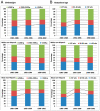Birth Prevalence of Cerebral Palsy: A Population-Based Study
- PMID: 26659459
- PMCID: PMC4703497
- DOI: 10.1542/peds.2015-2872
Birth Prevalence of Cerebral Palsy: A Population-Based Study
Abstract
Objective: Population-based data in the United States on trends in cerebral palsy (CP) birth prevalence are limited. The objective of this study was to examine trends in the birth prevalence of congenital spastic CP by birth weight, gestational age, and race/ethnicity in a heterogeneous US metropolitan area.
Methods: Children with CP were identified by a population-based surveillance system for developmental disabilities (DDs). Children with CP were included if they were born in metropolitan Atlanta, Georgia, from 1985 to 2002, resided there at age 8 years, and did not have a postneonatal etiology (n = 766). Birth weight, gestational age, and race/ethnicity subanalyses were restricted to children with spastic CP (n = 640). Trends were examined by CP subtype, gender, race/ethnicity, co-occurring DDs, birth weight, and gestational age.
Results: Birth prevalence of spastic CP per 1000 1-year survivors was stable from 1985 to 2002 (1.9 in 1985 to 1.8 in 2002; 0.3% annual average prevalence; 95% confidence interval [CI] -1.1 to 1.8). Whereas no significant trends were observed by gender, subtype, birth weight, or gestational age overall, CP prevalence with co-occurring moderate to severe intellectual disability significantly decreased (-2.6% [95% CI -4.3 to -0.8]). Racial disparities persisted over time between non-Hispanic black and non-Hispanic white children (prevalence ratio 1.8 [95% CI 1.5 to 2.1]). Different patterns emerged for non-Hispanic white and non-Hispanic black children by birth weight and gestational age.
Conclusions: Given improvements in neonatal survival, evidence of stability of CP prevalence is encouraging. Yet lack of overall decreases supports continued monitoring of trends and increased research and prevention efforts. Racial/ethnic disparities, in particular, warrant further study.
Copyright © 2016 by the American Academy of Pediatrics.
Figures


References
-
- Rosenbaum P, Paneth N, Leviton A, et al. A report: the definition and classification of cerebral palsy April 2006. Dev Med Child Neurol Suppl. 2007;109:8–14. - PubMed
-
- Boyle CA, Boulet S, Schieve LA, et al. Trends in the prevalence of developmental disabilities in US children, 1997-2008. Pediatrics. 2011;127(6):1034–1042. - PubMed
-
- Prager K. Infant mortality by birthweight and other characteristics: United States, 1985 birth cohort. National Center for Health Statistics. Vital Health Stat. 1994;20(24) - PubMed
-
- Mathews TJ, Menacker F, MacDorman MF. Centers for Disease Control and Prevention, National Center for Health Statistics. Infant mortality statistics from the 2002 period: linked birth/ infant death data set. Natl Vital Stat Rep. 2004;53(10):1–29. - PubMed
MeSH terms
Grants and funding
LinkOut - more resources
Full Text Sources
Other Literature Sources
Medical
Miscellaneous

